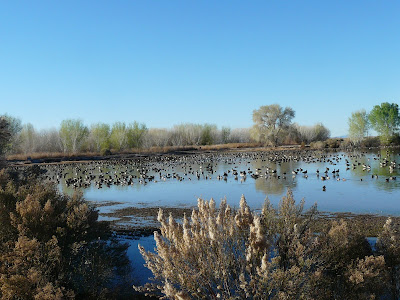Another cool thing about Cibola NWR was their population of burrowing owls. They built these habitats for them all along the drive loop area and, for the most part, they would let you drive up right next to them, stare, and take photos. They would usually just stare right back! We loved their yellow eyes and heads that could rotate 180 degrees.
About 2000 acres are farmed to provide food for migrating and wintering waterfowl, cranes and other species. Through a co-op agreement, farmers harvest hay in the summer and leave alfalfa, corn, mile, millet and other crops for wildlife during the winter. Below you can see mule deer co-existing with the Sandhill cranes on such a field. Cibola NWR is a relatively new refuge, established in 1964 to provide this important refuge for migratory birds, wintering waterfowl, and resident species. Cibola contains several miles of historic river channels and backwaters of the Co River that provide the habitat for the birds. There are about 240 different species of birds that use Cibola during the year.
Some Sandhill cranes. We love their distinct red "visor" head accents.
This was our workspace at Cibola. We could walk from our trailer to the office which was so convenient. This space also had a giant television set, hooked up to digital tv, so we could watch anything we wanted in the evenings. What a treat - a dose of civilization!A noisy flock of snow geest above our trailer canopy. We loved listening to them, this time during our lunch.
The view from our trailer was of the farm fields and part of the drive loop. There was constant activity in those fields during the days with all of the birds coming and going. They loved it there.
Above is a photo of the refuge nature trail, just behind the visitor's center. I spent a few sunsets on that observation deck with my binoculars, watching the cranes, ducks and geese fly into the refuge ponds.

There was another section of the refuge called the Hart Mine Marsh where we spent many evenings walking/running/watching cranes come in to roost for the night. The refuge staff spends the spring and summer months prepping the marsh and field areas for the wintering waterfowl. The water for the marshes comes from the Colorado River and has to be channeled in.
There was a well-maintained road that ran along the Co River, through the refuge that Oliver and I both enjoyed exercising on. Cibola is adjacent to Imperial NWR, both on the Co River. However, to drive from one to the other takes two hours!
The Sandhill Cranes flying to find a place to roost for the night. This was the view from our trailer.
This is Steven, the refuge biologist at Cibola. Don't get him started talking about his beloved home state of Arkansas....

We both really loved watching the cranes come in to roost in the evenings in the Hart Mine Marsh area of the refuge. It brought us back to our days at Muleshoe NWR in Texas where we had our first experiences with the cranes. Their sound is mezmerizing and they are a joy to watch in-flight.
This is Stephanie, the other biologist at Cibola. She is from Nebraska and spends at lot of her time with the birds...pretty cool job, huh?
Above is Jan and Samantha showing off their Valentine's Day manicures. Sam is an SCA at Cibola and Jan, with her husband, Randy below, is a volunteer. Jan and Randy are from South Dakota and travel the country in their beautiful RV, volunteering at various parks and refuges. They were our neighbors during our time at Cibola.

Inside their wonderful visitor's center and gift store. I bought myself a sandhill crane pin here.
This part of the country plays host to "feral burros", wild donkeys that have sustained themselves after being left my minors and farmers back in the hey-day "rushes" for gold, silver and other precious minerals that were mined in these parts. The burros have become a real nuisance for refuges to manage because they are non-native and are very destructive to the landscape. They also replicate at a very high rate, making the challenge even greater. These photos were taken from the drive loop at Cibola. Oliver frequently saw burros on his runs on the back areas of the refuge.
This is the view of the refuge complex from the outer part of the drive loop. You can see our trailer under the canopy that is second from the right. Below is the informational sign at the nature trail that is out along the drive loop. It leads to what is called the "Loafing Pond" - another place for the birds to hang out.















































































































Hi we are the Andersons Joe & Murlene. We have just talked to Bill S. and will be working at Cibola this winter. Would enjoy talking with you. Our email is swedejoe@gmail.com
ReplyDeleteRegards
Joe